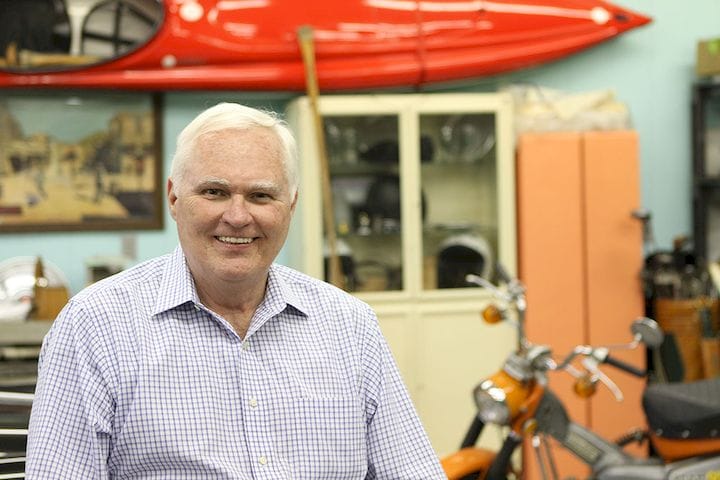![The inventor of 3D printing [Source: Bill Masters]](https://fabbaloo.com/wp-content/uploads/2020/05/image-asset_img_5eb0a57adf155.jpg)
We all know that 3D printing was conceived in the mid-1980s, but the person who did so first is probably someone you’ve never heard of.
The story everyone now understands is that of the two founders of the giant companies of 3D printing, 3D Systems and Stratasys. In August 1984, Charles Hull patented what would become the SLA process, and in the process 3D Systems grew to today’s behemoth.
Some years ago I was fortunate enough to hold the very first 3D printed object, made by Hull, which still exists and is considered a treasured object by 3D Systems.
Similarly, Scott Crump developed the FDM process, which was patented in 1989. This technology grew into Stratasys, one of the largest 3D printing companies today.
Those two inventors are largely credited with the creation of 3D printing as it exists today. But is this actually the case? We were pointed to another earlier patent by another inventor, Bill Masters of South Carolina.
On 2 July 1984, thirty-seven days before Hull’s patent, Masters patented US4665492A, “Computer Automated Manufacturing Process And System”, which upon a long read, appears to genuinely be a process describing something very much like many of today’s 3D printing processes. The patent’s abstract:
“A computer automated manufacturing process and system is disclosed which includes a computer system which consists of a computer aided design computer and a machine controller which receives a file of coordinate information. An article is designed by means of the computer aided design subsystem and a data file of three-dimensional coordinate information is compiled. The coordinate information is input to the machine controller which controls servos and in a polar coordinate system. The servos and further control the position of a working head and working head so that mass particles are injected to arrive at predetermined coordinate points in the coordinate system to form an article. An origination seed is fixed at an origin of the coordinate system and the article is built up around the origination seed. Other coordinate systems and apparatus for locating the mass particles at the coordinates of a three-dimensional article are disclosed so that the article may be built up in a number of coordinate systems, and controlled environments.”
If you think this is a bit different from most modern 3D printing processes, you’d be right. This is an unusual approach inspired by the idea of “spitting wads”. Masters explains:
“When you shoot a lot of wads, they begin to take shape. If you can control the direction of the wads and the motion of the device shooting them, you can produce any desired shape.”
![Bill Masters’ first 3D print; earlier than Charles Hull’s? [Source: Bill Masters]](https://fabbaloo.com/wp-content/uploads/2020/05/image-asset_img_5eb0a57b4ea87.jpg)
Thus we have a device that is designed to shoot particular matter at a target, where it would somehow adhere and gradually take on a desired 3D shape. It’s not clear to me exactly how the adhesion would have taken place, and the patent itself describes several scenarios for making this happen, including heating the internal atmosphere, applying an energy beam and more.
The patent seems pretty vague at points about the specifics, describing multiple approaches. For the mechanical system used to continually reorient the “gun”, as it is referred to at times, multiple designs are proposed. One is a very unique “polar” method that involves the gun sliding along a rotating torus to achieve desired positioning.
![The unusual polar mechanism of an early 3D printing concept [Source: Bill Masters]](https://fabbaloo.com/wp-content/uploads/2020/05/image-asset_img_5eb0a57b9c231.jpg)
Masters formed a startup company to exploit the ideas, originally Perception Systems and later called Ballistic Particle Manufacturing. This firm did receive some investment and actually produced and shipped to clients sixteen “Personal Modelers”.
![The “Personal Modeler”, a very early 3D printing beta unit [Source: Bill Masters]](https://fabbaloo.com/wp-content/uploads/2020/05/image-asset_img_5eb0a57bec496.jpg)
Unfortunately it seems that the company closed in 1997, and Masters moved on to developing innovations in the kayaking industry.
In those early days of 3D printing no one even knew what to call the technology; “3D printing”, “Additive Manufacturing” were just words. The technology was so new the emerging companies of the time had difficult challenges marketing it to clients who had no idea what to do with the process and were set in their ways.
The several new 3D printing processes from the ‘80s were cycled through the market by the startups and, as we know now, FDM and SLA won the battle. Whether it was the technology itself, the marketing program, the amount of investment or company management, Masters’ “BPM” was simply not adopted by clients and his company and invention faded into history.
Since then FDM and SLA have been joined by many other powerful 3D printing processes, with new ones still under development, some thirty-four years later.
The moral of the story here is simply this: being first doesn’t mean you’re going to win.
Via Bill Masters and Google Patents












1 comment
Comments are closed.